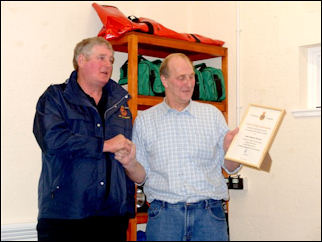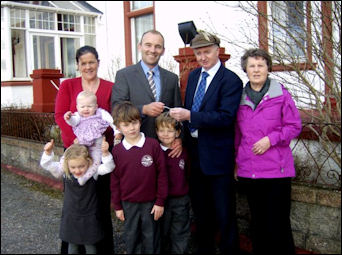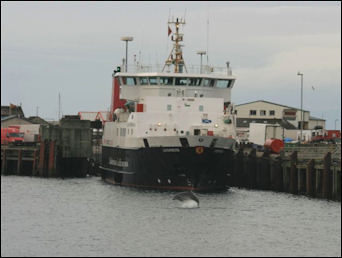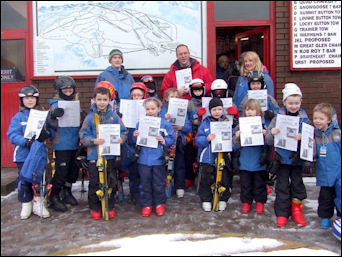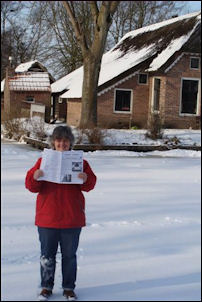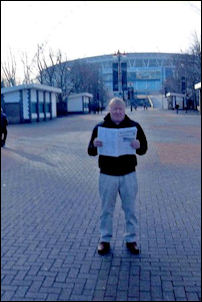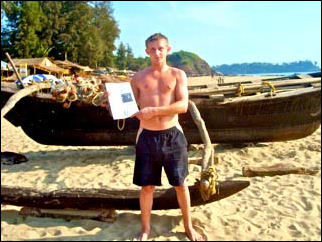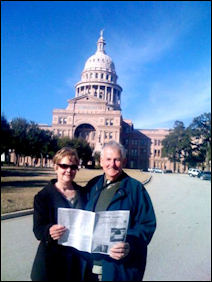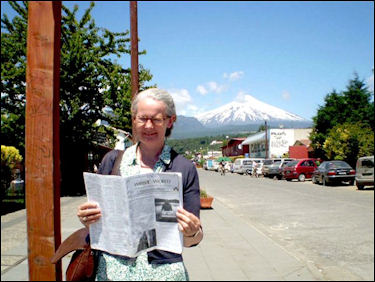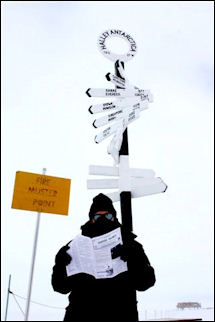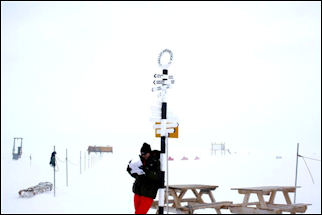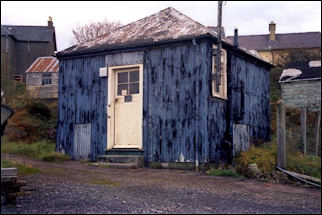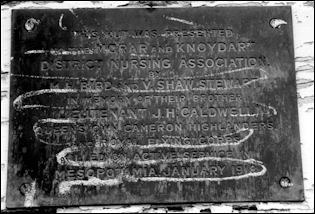MALLAIG HIGH SCHOOL HOSTEL WELCOMES FIRST RESIDENTS
Mallaig High School's new £4 million residential hostel welcomed its first residents on Monday 1st March 2010.
The new hostel enables the Council to meet its longstanding ambition to provide suitable residential accommodation for pupils from Canna, Eigg, Knoydart, Muck and Rum attending Mallaig High School to be accommodated as one group.
The three-storey, 21 bedroom facility, was built by Les Taylor Construction and stands on an elevated site adjacent to the school, which was donated by Sir Cameron Mackintosh.
Sponsored by the Council's Education Culture and Sport Service, the building has been designed by architects in the Council's Housing and Property Service. The new facility provides a comfortable, safe and homely environment for those staying at the facility. The design includes provision for dining, quiet space, social areas and maximises the use of the site through its access and views from the bedrooms.
It opens with 12 residents and over the next three to four years will build up to its capacity of 30 residents. Supervising the hostel will be Mrs Mairi Maclean, who has been looking after the children's lodgings over the past five years.
Councillor Michael Foxley, Leader of the Council's Administration, said: 'This is a major investment by the Council and recognises the importance this council attaches to our rural communities. Not only will the hostel provide pupils with a stable environment and certainty as to where they will be staying during their secondary school career it will also be a useful community resource out with school terms for residential workshops and holiday accommodation.'
Councillor Allan Henderson, Caol and Mallaig Ward, added: 'The hostel is a real community asset. The children of Knoydart and the Small Isles will have one of the finest living environments whilst continuing their studies. They will be the envy of 5 star hotels worldwide, with the spectacular views afforded from the hostel.'
Martin Sullivan, head teacher of the 135-pupil school, said: 'The new hostel is very good news for the school and the community. We are very grateful to the families that our pupils have lodged with over the last ten years. They have done an excellent job.
'However, what a benefit it will be having all the children from the Small Isles and Knoydart under one roof, where they can gain support from each other and have professionals on hand to address their individual and common concerns. The hostel will make it easier for pupils to make friends and adapt to life away from home.'
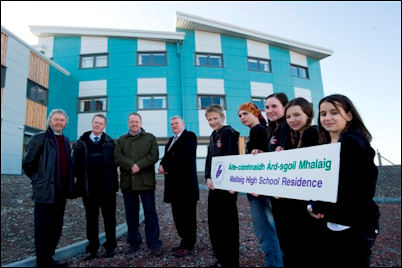
L to r: Councillors Michael Foxley, Allan Henderson, Bill Clark, Eddie Hunter and the first resident pupils Jamie MacEwen (Isle of Muck), Galen Brook-Atkins (Knoydart), Sorcha McEoin, (Rum), & Charlotte and Nicole Johnstone (Eigg).
Photo courtesy of Iain Ferguson, The Write Image
BEST IN THE WORLD - TWICE OVER!
The recently released Time Out Guide to 1000 Great Holidays Ideas states that the Road to the Isles, the A830, has reached 'mythical status' and names it in the Top Ten of the world's best drives!
In addition, for the second year running, readers of the travel magazine Wanderlust have voted the West Highland Line as the Top Rail Journey in their 2010 Awards, over the Trans-Siberian Express and rail journeys in Peru, the Rockies and New Zealand. It is described as 'authentic' with welcoming staff, and with scenery unmatched for sheer variety and constant interest.
KNOYDART
Hello
Don't hardly know how I've got the time to write this what with keeping up to date with the outbreak of Facebook mania on the peninsula. Everybody and their sister seem to be putting pictures on and setting up sites. From Knoydart Festival and Knoydart Pottery to the fabulous Gerry's Pizzas and the odd odd picture of chair surfing Facebook is certainly the place to look. But not every aspect of the Knoydart social whirl gets its own page. Jim and Claire's wedding bash may be online but don't know if it will tell you that Liz Tibbets and Jane Davies were (apart from the happy couple) the stars of the show: playing, singing and dancing the night away until they were the last people standing. Likewise last week's low-key locals ceilidh (where Andy's box didn't fall apart), Jim Hunter and friends' recent visit to the pub and Mark Woombs' talk on the Red Sea at the village hall are all unlikely to have made it online but all were hugely enjoyable nonetheless. The now traditional Pancake Day races are likely to be on a page somewhere but how could mere pictures capture the tensions (and the cheating) during Jim and Tommy's face off.
One aspect of Knoydart life that rarely gets written up is the huge effort that goes into raising money for various charities. Last week we had a book sale for Amnesty along with a soup kitchen for Oxfam which raised £150 and £200 respectively. Earlier on in February there was an auction for Haiti disaster relief, including a bidding war between Victor and Chic (both notably short-haired or less) for a haircut, which raised over £1100. Big thanks to Gwen, Angie, the schoolteachers, all the kids and Isla, Rhona and Rhona for all the organisational efforts there. In the coming month, although as ever much secrecy surrounds the detail, there will be the charity blitz, fun and frolics which is the Knoydart version of International Women's Day. And for the rest of the year one of our home grown charitable organisations - the village hall - will be having a fundraising drive, looking to raise funds towards a future renovation of the current, much loved, building.
And of course work goes on. The Builders have started on the new house on the hill for Ian and Jackie and look to have a massively busy year with the planning permissions starting to come through for the affordable housing that the Foundation is building in Inverie and Airor. The Foresters are gearing up for a big planting splurge in March: the tell tale white boxes were piled high on the back of their pick-up the other day. And all the holiday accommodations are getting ready for what promises, so I'm told, to be another big year. Of course Hydro work and maintenance will continue all year with transformer renovations and line load puzzles to keep everybody busy.
Meetings never end in small communities. A very productive and positive example was one held over at Airor to discuss the new house and possible re-developments centring around crofting and land-tenure. A village-wide mini-hydro scheme was also touched on and since then there has been some positive preparatory investigation done by John Duncanson. Hope it all moves on apace. Talking of developments the architect Neil Sutherland is due to give a community presentation in March on the first draft of the feasibility study for the Forest Trust Workshop. Also in March the Community Land Unit are using Knoydart to host a social enterprise conference.
Add to all of the above the successful funding bid coming in through the Powerdown post for the Market Garden along with the positive look to the end of year accounts for the three community companies and Knoydart stuff seems quite positive at the moment.
Finally just a couple of get wells to Tim Bowyer and David Haynes. We all wish you both speedy recoveries. A happy 60th to Stewart Miller. And a well done you to Fraz for keeping off the fags. Also apologies for the lack of Knoydart column last month.
cheers
Davie Newton
ISLE OF MUCK
It's open at last - the new school hostel in Mallaig; and it must be good news for the Small Isles parents and children. Provided it is run by competent and caring staff it must be an improvement on at least some of the lodgings which went before and which were increasingly difficult to find as the number of secondary scholars grew. I have not visited the hostel but I am sure that inside it is very fit for purpose. However I must take issue with one aspect - the exterior. I know the site was difficult but surely the architect could have designed a building more in keeping with the others in the complex, not a return to the 60's complete with multi monopitch roof! Architecture and design is very important- what we build today will be with us for a long time. So it was that last September I went to see the new Scottish Parliament. Could it be as bad as it appears on TV. It was worse! A totally uninspiring structure designed to cost one fortune to build and and another to maintain over the next 100 years. Strangely enough if anyone would like to see really excellent vernacular design (not quite on the same scale!) you need go no further than this island where my brother Ewen is building himself one of the most attractive houses you are ever likely to see!.
On the farm it is tree planting time and a team of islanders are on the slopes of Ben Aerean in the sunshine hard at work with spades and mattocks. It is now Monday night but since last Wednesday they have planted nearly 7000 native hardwoods and Scots Pine. Duggie the dyker is now gone - to Canna, leaving behind him a lasting memorial to excellence in the world of dry stone dyking.
Lawrence MacEwen
ISLE OF RUM
Hi we're Cara Kilpatrick and Nell McEoin from Rum Primary and we are going to be writing the Rum article in the West Word every two months. Hope you enjoy our articles.
We interviewed Sarah Bentley from SNH and she told us that SNH are going to fix the power system on Rum. They are going to insert a new battery inverter, which will start in April.
There will be a deer hide built at Kilmory to watch the deer especially during the rutting season.
The reserve office is being upgraded. So it should look good when it's done. There will also be a visitor survey to find out what people like about Rum and what would make Rum more exciting. That's also in April.
We have also interviewed Mr Poole from Rum Primary School about glow and future ideas for the school. Glow is an online site, which connects schools, so they can talk and see each other on the computer. This is only a school site but if you are part of a school and you have a username and password for glow, then you can go on at home or at a library. Rum Primary is also taking part in World Maths Day. This is a site, where you can compete against other people in your year all over the world.
Well that's all we have got for this article this month.
Cara Kilpatrick & Nell McEoin
NEW BOUNDARY SHARPENS RUM RESERVE'S FOCUS ON NATURE AND WILDLIFE
The area of land covered by the Isle of Rum's National Nature Reserve (NNR) designation is to be adjusted following a review by Scottish Natural Heritage (SNH). The move is the latest recommendation of the organisation's ongoing national review of all Scotland's NNRs to ensure reserve boundaries match with their nature conservation objectives.
The Rum SSSI and NNR review identified areas around Kinloch Village, including the policy woodlands and the Kinloch fields, which do not support any qualifying natural features. Their removal outwith the Rum SSSI and NNR boundaries now means these areas are no longer governed by these nature conservation designations. However they remain important landscape elements of the Small Isles National Scenic Area and the designed landscape around Kinloch Castle.
Kristin Scott, SNH Area Manager for West Highland said:
'Many of these designations date back decades so they need to be reviewed from time to time to consider changing circumstances. On Rum we concluded that the land around Kinloch Village does not host any SSSI features and was of little significance to any of the bird populations protected by the Rum Special Protection Area (SPA). This recommendation was included in our recent consultation on the management plan for Rum NNR.'
The SSSI on the Isle of Rum currently covers the entire island, down to the low water mark, including the solum of Kinloch Castle, land around Kinloch Village and all other buildings. The NNR boundary and that of the SPA (for seabirds, divers and golden eagles) are both coincident with this boundary. The SAC in contrast, does not include the areas around the village and the fields, nor the intertidal zone in front of Kinloch Village.
ISLE OF EIGG
Another dry, freezing sunny month on the island: a month that well deserves its Gaelic name of "wolftimes". Although we could get used to this Scandinavian weather, however, for those whose water has frozen on and off for the past 2 months, it is getting a bit tiresome. It certainly was a bit bothersome for our latest newcomers to the island: Claire Miller and Phil Seddon from Manchester, who managed to settle quite well in Forester's Cottage despite no water since they arrived at the beginning of the month, and no electricity for the first few days. But they have taken it very bravely, rolling up their sleeves and starting on the 40 leaks or so they identified in the plumbing! They got to meet everyone in a oner at Brian Greene's 60th birthday party on the 19th which was a really great night, marking exactly 30 years since Brian's 30th party saw practically the whole island gathered in the Smithy bothy! The shop had run out of red cans, and everyone turned up with a dram or two, so that we started our island life with quite a bang! Thanks a lot to Ben Cormack for providing another bang with his great firework display with 60 stars in it!
The party carried on for another day for Michaela Hunter's 40th! Having volunteered on Eigg a few years ago, Michaela who now lives and works in Argyll and is involved with woodlands and the Dunbeag permaculture centre in Argyll, brought a bevy of pals with her and we all had another great night.
The music scene on Eigg is certainly set to expand, with Phil's guitar playing, and Richard Reason's piano playing, as Richard, an old friend of Eigg, has finally succeeded in buying his dream house on Eigg (the Robertson's house in Cleadale). We are looking forward to seeing a lot more of him and his family and friends.
So Eigg's population is set to change substantially with all these new folks, and this has made us all think a little bit harder about our the review of our Housing policy. One thing which is certain in life is that things never stay the same!
In the meantime, February has also been a exciting month for John Chester who visited our faithful Dutch wildlife volunteers in their now frozen landscape in Arnhem, and even more so for the Carr family as Marie, Colin and Frances flew to Thailand with Amy and Donnie to meet up with Greg who then took them on whistle stop tour of Vietnam so that they would get a good idea of his way of life out there. Everyone had a good time, as can be seen on Facebook! Francis vows she is going back next year! And now it is our turn to fly to the other end of the world, as Brian and I are poised to meet our daughter Felicia in Kerala before she heads up for the Nepalese border and a wee visit to Tamsin and Stu. So there is a positive side to turning 60 after all!
Sin agad e!
Camille Dressler.
GILLE BRIGHDE - ISLE OF CANNA'S NEW CAFÉ / RESTAURANT
The new café/restaurant on Canna will be open for business as the Cal Mac ferry timetable changes around Easter. Amanda McFadden and her partner Aart, who is Dutch, moved to the tiny island at the beginning of the year and have been busy making a few changes to the old tearoom as well as giving it a new name.
The move has increased Canna's resident population to nearly 20. When the opportunity to run the restaurant was advertised last summer, it created huge interest, with more than forty people wishing to apply. The applications were whittled down to nine, then four; and Amanda and Aart were chosen by the islanders to take the business forward. They had never visited Canna before applying but the style of life attracted them.
Both of them have a background in the catering business and most recently were running the kitchen at the Kingairloch Estate, Ardgour.
Although its roots are Scottish the restaurant won't be too themed - just a real taste of the local produce, well presented and fairly priced. The inside décor has a rustic island feel with the emphasis on relaxed informal dining and simple honest hospitality.
Amanda & Aart say 'The aim is really to combine a lifestyle that suits us in the long term, and to be able to integrate the business and ourselves into the island as a whole.
'We genuinely believe Canna is a wonderful wee island, the opportunity to live and run our own business was too good to miss. It is a privilege to live somewhere so unique. We enjoy being part of the 'real' working community and we want the restaurant to provide a memorable experience for the visitors to the island. Our passion is food and we will be serving local, fresh food in a creative but simple and delicious way. The restaurant's new name is Gaelic for the Oystercatcher and we feel this is a good symbol for our hard-working little restaurant, the bird can be found all along the shore and adds a splash of colour to the bay.'
The Gille Brighde will be serving light lunches and homebaking during the day and in the evenings offers a rustic fine dining menu. Sunday lunch will also be available.
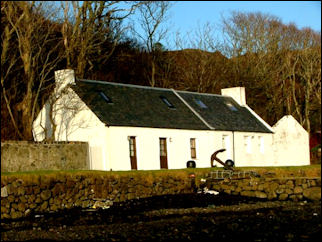
Canna has a huge amount to offer, first and foremost a place of great natural beauty with a wonderfully varied wildlife, scenery, intriguing history and heritage and is home to one of the largest collections of Gaelic lore and culture. It has a safe harbour offering good anchorage as well as regular ferry crossings from Mallaig and RIB cruises from smaller independent operators
Accommodation is available on the island for those wanting to stay a little longer, from wild camping through NTS Self Catering Cottages to the lovely Tighard Guest House.
The telephone number of the restaurant is 01687 460164.
ARISAIG
Another new house going up on the main street in Arisaig - now there will be buildings all the way from the café up past Strath to the bypass junction! Good luck to Ronnie and Martine now they've moved into their new home with a grandstand view of the bay!
Some freezing people in the Hall last month - there was a blockage in the fuel pipe from the tank to the boiler. It was fixed very quickly - once I knew there was no heating. I wonder why, when people had known for several days that it wasn't working, I wasn't told until Friday afternoon?! I couldn't even ring up to organise a repair until the Monday.
The evening classes seem to be going well! Aromatherapy and Geology are on now. One night the computer class 'borrowed' my internet connection, Mark had a wire going out through a window, across the fence and our garden, and up into the little room I grandly call my office (skip is more like it). Unfortunately when he went home my internet connection seemed to go with him. Luckily I worked out how to get it back after a day or two.
I took P1 - 3 round the Land Sea & Islands Centre today (9th March), a whistlestop tour of the various boards and displays. I hope there will be more school trips.
A free standing display on the SOE memorial ceremony is being designed under the direction of Dr Paul Millar, - I'm not sure if it's being done in the Czech Republic but I rather think so. It will go in the Land Sea & Islands Centre when it gets here.
We have been wondering where the fast expanding family of rooks might build nests next. They've been up at the back road crossroads for a few years now. We thought they'd picked a rather whippy ash tree behind Highland but it turns out they, like the hoody crows, are snapping off twigs to build or reinforce their nests. Incidentally, I've just found out that a group of rooks is called 'a building', or sometimes 'a clamour' and they bring good luck if present on your land. So now you know…
Ann Lamont
